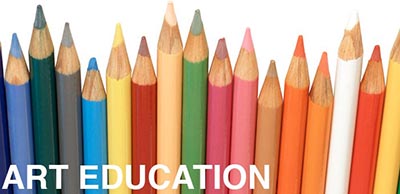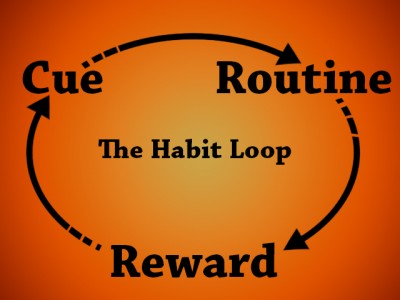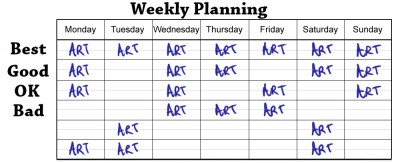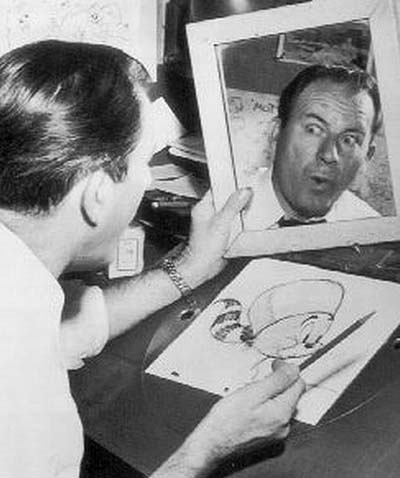
While practicing your craft you may find yourself wanting to devote time to practice, but finding either little available time, or a lack of motivation to begin work. Commonly, many artists will wait for inspiration to strike before they begin working, and then will feverishly work for hours on end while the inspiration lasts. Later these same artists many times leave their work unfinished, forever waiting for their fickle inspiration to return. Others are frequently paralyzed by indecision as they wrestle to find the right idea to work on in the right way. Even productive artists can suffer from their habits, working themselves sick by missing out on sleep and meals.
If these scenarios describe the way you work, then what you need is to form your own Practice Habit. Consider the many daily activities you do without any prompting: eating meals, brushing your teeth, watching a show, etc. For almost all of us, our daily lives are filled with activities which we perform at the same time in the same way every day, which we no longer even think about. We want your artistic practice to be one of these automatic activities (or at least we want starting practice to be automatic, not the work itself).
The Habit Loop
We can use certain psychological tricks to establish and reinforce behaviors until the become second nature. Doing this takes time and discipline, but once established, makes work pleasant and regular. I have experimented on both myself and on students in using this method and have had much success altering our habits for the better over a period of about a month before the habit was solidified.
It’s important to note that replacing an established habit with a new one is much harder to do than institute a fresh habit without competing. Therefore starting this process immediately following a vacation or the end of a school quarter is particularly effective. Additionally, any disruption of your routine which lasts more than a week may destroy your current habits and force you to establish new ones.
Cue
Firstly, you need a signal to activate your habit. This can be as simple as an alarm on your phone or computer, or you can piggy-back on an existing cue such as the end of work, class or a meal. Make sure that the cue is unavoidable and clear so that you don’t accidentally miss it.
Routine
This is your actual practice. You should set up your work space and materials in the same way, preferably in the same place every time you begin work. As we’ll see, the work itself shouldn’t be exactly the same day to do lest you risk artistic stagnation, but the circumstances under which you work should be as consistent as possible to reinforce your habit and reduce distraction.
Reward
This is the positive feeling or result of having worked. You can also use a material reward on yourself if you find it necessary such as a snack or a game. With artistic work, this is usually not needed because the work process itself is quite rewarding on its own.
Be Consistent
We want to create a daily artistic practice, meaning that if at all possible, you should pick a time to work which is available seven days a week, every day of the month. Because of work and family obligations, working on your art everyday may not be possible. Obviously we want to skip as few days at possible, but if you must skip a day, try to make it the same day every week or try to pattern the days to skip the fewest number of consecutive days. The worst case scenario which will still work for establishing an art habit, is to work on your art every other day.
Take the time of day into consideration as well. Most people have a particular time of day which is best for working, so try to think hard before choosing your’s. In the past when you’ve worked on your art and felt good about it, was it early in the day? Was it immediately after lunch? Late at night? Whenever it is for you, try to make that time your work time.
Similarly, you should pick a work space which is consistent as well. Being in the same place will help to reinforce your habit by making the physical location a part of the routine. Try to pick a place which is always available to you and free from distraction.
Plan to Begin
The goal for habit forming is to start working. That’s it. It doesn’t matter if you then proceed to work for an hour or for 10 minutes, the important thing is to establish a time to begin working and allow for time to continue if you feel like it (in my experience, most artists will happily continue working, but starting work is the hard part).
Now you may be saying to yourself, “Why shouldn’t I plan to work for a few hours?” Forcing yourself to work, although necessary in a professional environment, is not what we should do for our personal practice, and the reason why has to do with the Reward step in the Habit Loop.
Imagine that you begin work and can’t do anything right that day. You try and fail, and force yourself to keep going for the whole duration of your planned time. You feel awful right up to the end of the session and exasperated, quit when the allotted time is up, happy to be done with it. How will you feel the next day when you have to sit down to start work again? Do you think those negative feelings might influence your attitude when you start working the next day? For me, and for many of my students, it does, which is why I never recommend forcing a set duration of work.
Instead, I recommend planning a start time only, providing available time to work in if it happens that day. The benefit of this is a lower amount of pressure daily and permission to fail to work on a given day without heaping guilt on yourself. So you didn’t get anything worth while done today? So what? You worked yesterday and you’ll work again tomorrow due to the daily component of your practice habit. Consistency is very freeing, as it ensures that regular progress takes place, while providing forgiveness for work lulls.
Don’t Distract Yourself!
Remember that the purpose of this time is for personal work only. This means don’t turn on the TV or Netflix, don’t listen to podcasts, don’t start an hour-long phone call while working. Concentrate on only your art. As stated in Richard Williams’ “The Animator’s Survival Kit” this advice alone has the power to radically increase your productivity.
The compound problem with working while distracted is that we’re trying to establish a practice habit. This means that if you establish a habit of working while watching Netflix, you will always need to work while watching Netflix! Don’t make a distraction a part of your habit.
If you’re working at home or in a school lab, set yourself up for success by letting people around you know to leave you alone at this time. Turn off your phone if you have to. Sequester yourself in your locked room if you must. Do whatever it takes to get time with just you and your art, you wont regret it.
Use Motivation Tricks
Get others to monitor your progress. If you promise your friends and family to show them your work daily, then you must have work to show daily. This little trap can make it a lot more important to you to work consistently than working alone.
Work near other artists (or at least in parallel). If you can arrange it, have someone else establish a practice habit at the same time you do. You don’t have to work in the same room, but you should frequently check in on the other’s progress. There’s nothing wrong with a little competition.
Keep track of the amount of work you’ve produced. This is very simple, whenever you finish an animation, or painting, or page of drawings, add 1 to the total you’ve completed and keep the total number visible. Human beings love watching numbers tick upward, and this tiny effort can have a noticeable impact on your throughput (especially when combined with the previous method).
Set a numeric goal for your work. Anything will do, such as 100 drawings, or 50 seconds of animation, etc. A medium to short term goal is a great way to push your work forward and keep the wheels of progress turning.
Finally, remember to set small goals which you can maintain. When you realize that your previous goal has become second nature, set another small goal which builds on your first. If you are able to incrementally ratchet your work upward by small degrees, you’ll find that before too long, you’re much more productive than you were before.



































